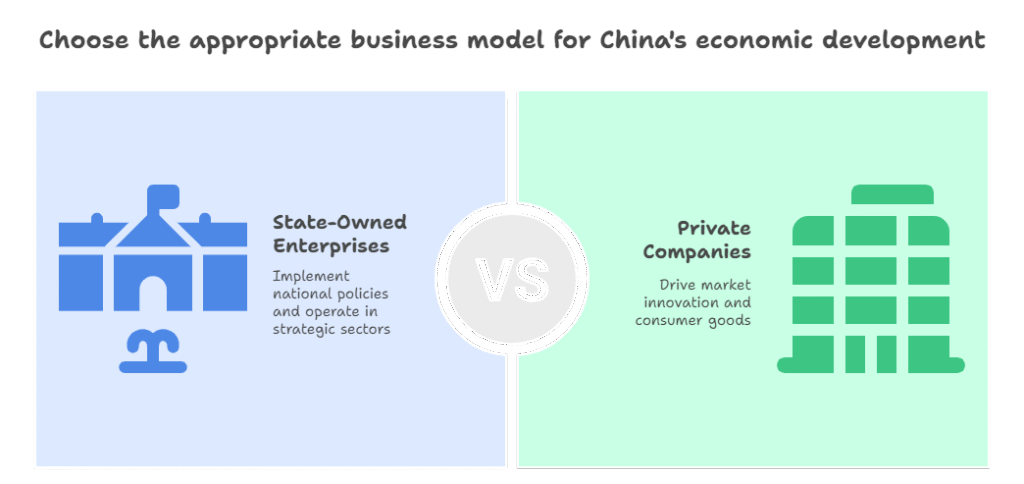When exploring business opportunities in China, one of the first and most critical decisions foreign companies face is choosing the right local partner. Broadly speaking, Chinese enterprises fall into two major categories: State-Owned Enterprises (SOEs) and private companies. Understanding the fundamental differences between them is essential for making informed, strategic decisions.
In this article, we break down the key distinctions between Chinese SOEs and private companies—from governance and decision-making to transparency and risk profile—to help you identify which type of enterprise may be the best fit for your collaboration goals.
What Are SOEs and Private Companies in China?

State-Owned Enterprises (SOEs) are companies where the state holds a significant or controlling stake. They often operate in strategic sectors such as energy, telecommunications, infrastructure, finance, and defense. SOEs are instrumental in implementing national economic policies and tend to be very large in scale.
Private companies, on the other hand, are owned and operated by private individuals or institutional investors. They are typically more agile, market-driven, and prevalent in consumer goods, technology, e-commerce, and services.
1. Governance and Ownership Structure
SOEs:
SOEs are ultimately accountable to the state. Their governance is influenced by government objectives, and they often have representatives from the Communist Party of China involved in top-level decision-making. Board members and executives may be appointed or approved by state-owned asset supervision authorities.
Private Companies:
Private companies are governed by their owners or shareholders. Decision-making is more flexible and aligned with market opportunities rather than policy goals. Corporate structures are often simpler, with a clearer chain of command.
2. Decision-Making and Speed
SOEs:
Decision-making in SOEs can be slower due to bureaucratic layers and the need for alignment with government interests. Large investments or strategic shifts may require approvals from multiple supervisory bodies.
Private Companies:
Private firms usually have shorter decision cycles. They can pivot quickly in response to market changes, making them ideal partners for projects requiring speed and adaptability.
3. Transparency and Disclosure
SOEs:
While large SOEs are often better documented than many private companies, their reporting may emphasize policy compliance over operational transparency. Financial disclosures can be complex and may not always reflect market-based performance.
Private Companies:
Transparency varies widely. Well-established private firms or those seeking foreign investment often adopt international reporting standards. However, smaller private companies may lack rigorous disclosure practices.
💡 Tip: Whether you’re engaging with an SOE or a private company, conducting thorough due diligence is critical. Our Enterprise Credit Report provides official insights into a company’s legal and financial standing.
4. Risk and Stability
SOEs:
SOEs are generally considered low-risk in terms of solvency and continuity due to state backing. They are less likely to fail, but may also be subject to sudden policy shifts.
Private Companies:
These companies carry more market risk but often offer higher innovation potential and flexibility. Their stability depends on leadership, market position, and access to capital.
5. Innovation and Culture
SOEs:
Traditionally seen as less innovative, SOEs are now increasingly investing in R&D, especially in tech and green energy. However, their culture may remain hierarchical and procedure-driven.
Private Companies:
Known for agility and entrepreneurship, many of China’s most innovative companies—like Huawei, Tencent, or Alibaba—are privately held. They tend to foster competitive, performance-oriented cultures.
6. Partnership and Cooperation Models
SOEs:
Ideal for large-scale projects, public tenders, or sectors requiring government liaison. Partnerships with SOEs can provide market access and regulatory support.
Private Companies:
Better suited for joint ventures, technology transfer, consumer markets, and fast-moving industries. They are often more open to foreign collaboration and equity participation.
How to Choose the Right Partner?
- For large infrastructure, energy, or policy-driven projects: SOEs may be more suitable.
- For tech, consumer products, or agile cooperation: Consider leading private companies.
- Always verify credentials: Regardless of type, always validate business licenses, ownership structure, and financial health.
✅ Get the Full List of China’s Central SOEs and Top 500 Chinese Private Enterprises
To help you navigate the landscape of state-owned enterprises and top Chinese Private Enterprises, we’ve compiled an updated directory of China’s 100 central SOEs and Top 500 Chinese Private Enterprises You can download them here:
Download: List of China’s 100 Central State-Owned Enterprises
Download: Top 500 Chinese Private Enterprises in 2025
Final Thoughts
There’s no one-size-fits-all when it comes to partnering with Chinese companies. Your choice should align with your strategic goals, risk tolerance, and the nature of your project. Whichever path you take, ensure you enter partnerships with clear insight and confidence.
At ChinaBizInsight, we help international businesses verify, understand, and engage with Chinese enterprises through reliable corporate intelligence and due diligence services. Feel free to explore our service portfolio or reach out for a consultation.
